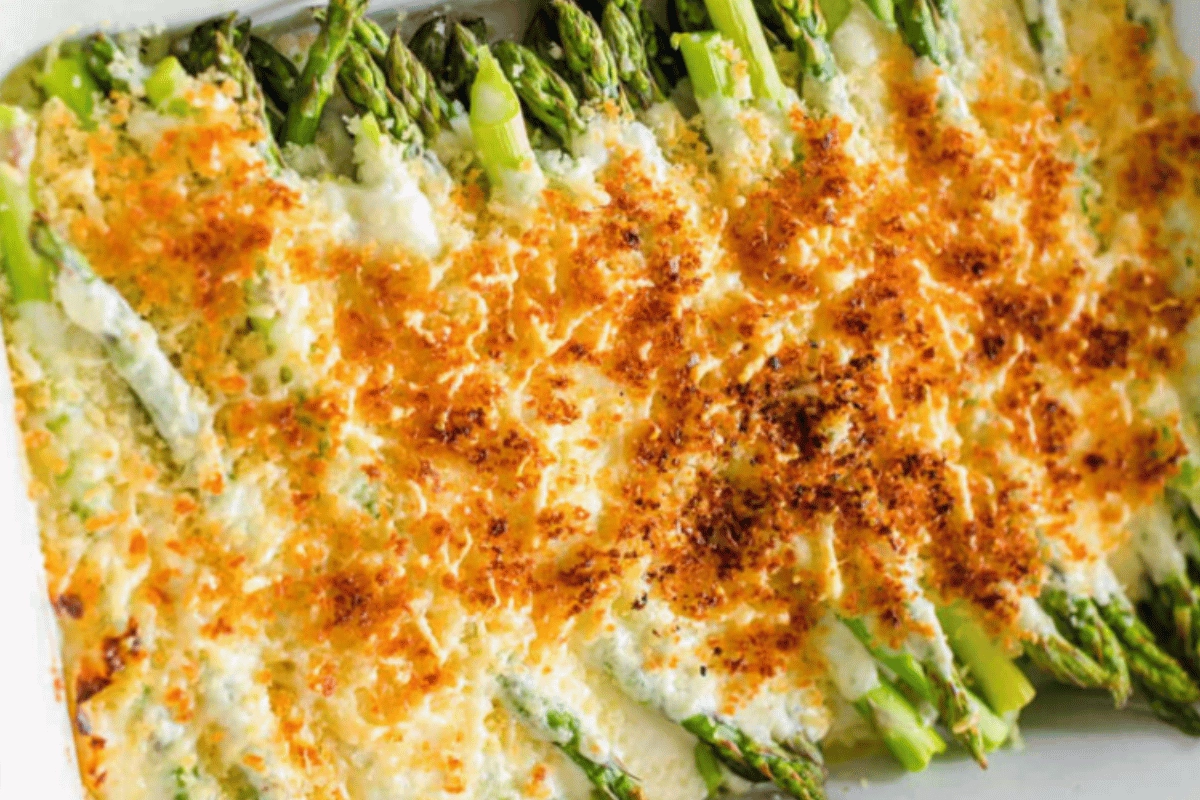INDRODUCTION
In this article, we’re delving into the world of asparagus casserole, a beloved dish that combines the freshness of asparagus with the comfort of a cheesy, baked casserole. Whether you’re a seasoned cook or a beginner in the kitchen, understanding the intricacies of cooking time and temperature is crucial to achieving the perfect asparagus casserole. From selecting the best asparagus to the final baking process, we’ll guide you through each step to ensure your casserole is a hit. So, let’s embark on this culinary journey and unlock the secrets to a delicious asparagus casserole.
Preparing Asparagus for the Casserole
Before you dive into assembling your asparagus casserole, it’s essential to prepare the asparagus properly. Here’s how to ensure your asparagus is ready for the casserole:
- Selecting the Best Asparagus: Look for bright green asparagus spears with firm, tight tips. The stalks should be stiff, not limp or wrinkled. Whether you choose thick or thin asparagus, ensure they are fresh and of good quality.
- Preparing and Trimming Asparagus: Rinse the asparagus under cold water to remove any dirt or grit. Trim the woody ends of the asparagus by bending each spear until it snaps naturally. This will remove the tough part of the stalk, leaving you with the tender portion.
- Blanching Asparagus (Optional): Although not mandatory, blanching asparagus can enhance its color and texture. To blanch, bring a pot of salted water to a boil, add the asparagus, and cook for 2-3 minutes. Immediately transfer the asparagus to a bowl of ice water to stop the cooking process. Drain and pat dry.
With your asparagus prepped and ready, you’re one step closer to a scrumptious casserole. Stay tuned for the next part, where we’ll discuss the ingredients you’ll need to bring your asparagus casserole to life.
Ingredients for Asparagus Casserole
Now that your asparagus is prepped and ready, let’s gather the ingredients you’ll need to create a delicious asparagus casserole:
- Asparagus: The star of the dish, fresh asparagus should be washed, trimmed, and, if desired, blanched.
- Cheese: A combination of cheeses, such as cheddar and mozzarella, adds creaminess and flavor. You can also use Parmesan for a sharper taste.
- Cream of Mushroom Soup: This classic ingredient provides a rich and savory base for the casserole. You can also use other cream soups for variation.
- Milk or Cream: Adds moisture and helps create a smooth sauce.
- Butter and Flour: These are used to make a roux, which thickens the sauce.
- Breadcrumbs or Crushed Crackers: For a crispy topping, breadcrumbs or crushed crackers add texture and flavor.
- Seasonings: Salt, pepper, and optional spices like garlic powder or Italian seasoning enhance the overall taste of the casserole.
- Optional Add-Ins: Feel free to customize your casserole with additional ingredients like sautéed mushrooms, cooked chicken, or crispy bacon for added texture and flavor.
With these ingredients on hand, you’re well on your way to assembling a mouthwatering asparagus casserole. In the next part, we’ll walk you through the steps of assembling your casserole for baking.
Assembling the Casserole
With all your ingredients ready, it’s time to assemble your asparagus casserole. Follow these steps for a perfect dish:
- Layer the Asparagus: Begin by arranging the prepared asparagus in a greased baking dish. If you blanched the asparagus, make sure it’s well-drained.
- Prepare the Cheese Sauce: In a saucepan, melt butter over medium heat. Add flour and whisk to form a roux. Gradually add milk or cream, stirring constantly to avoid lumps. Once the sauce thickens, add the shredded cheeses and stir until melted and smooth. Season with salt and pepper to taste.
- Combine Asparagus and Sauce: Pour the cheese sauce evenly over the asparagus in the baking dish. Use a spoon or spatula to ensure the asparagus is well-coated.
- Add Toppings: Sprinkle breadcrumbs or crushed crackers over the top of the casserole for a crispy finish. You can also add extra cheese on top if desired.
- Bake: Preheat your oven to the recommended temperature (usually between 350°F to 400°F). Bake the casserole uncovered for the specified time, until the top is golden and the asparagus is tender.
- Broil (Optional): For an extra crispy topping, you can broil the casserole for the last few minutes of cooking. Keep a close eye on it to prevent burning.
Once your casserole is assembled and baked, you’re ready to serve a delightful and comforting dish. In the next part, we’ll discuss cooking time and temperature to ensure your asparagus casserole comes out perfectly.
Cooking Time and Temperature
The key to a perfectly cooked asparagus casserole lies in the right combination of cooking time and temperature. Here’s what you need to know:
- Preheat the Oven: Before assembling your casserole, preheat your oven to the recommended temperature. Most asparagus casseroles are baked at temperatures ranging from 350°F to 400°F (175°C to 204°C).
- Cooking Time: The cooking time for asparagus casserole can vary depending on the recipe and the thickness of the asparagus. Generally, you should bake the casserole for 15-20 minutes at 400°F (204°C) or 40-50 minutes at 375°F (190°C) if it includes a creamy sauce and topping. For casseroles with a thinner layer of asparagus or a lighter sauce, the cooking time might be shorter.
- Signs That the Casserole Is Done: You’ll know your asparagus casserole is ready when the asparagus is tender, the cheese is melted and bubbly, and the topping is golden brown. You can test the tenderness of the asparagus by piercing it with a fork.
- Broiling (Optional): For a crispier topping, you can broil the casserole for the last 2-3 minutes of cooking. Keep a close eye on it to prevent the topping from burning.
By following these guidelines, you’ll ensure your asparagus casserole is cooked to perfection, with tender asparagus and a deliciously golden crust. In the next part, we’ll explore some serving suggestions to complement your casserole.
Serving Suggestions
Once your asparagus casserole is hot and bubbly from the oven, it’s time to think about how to serve it. Here are some suggestions to make your meal complete:
- Main Dish Pairings:
- Beef or Pork: Complement the casserole with a main dish like Baked Pork Tenderloin or Air Fryer Steak.
- Poultry: Try pairing with Baked Bone-In Chicken Breast, Grilled Chicken Thighs, or Spatchcock Turkey.
- Seafood: For a lighter option, serve alongside Garlic Butter Halibut or Air Fryer Shrimp.
- Side Dishes:
- Add a starchy side like Instant Pot Mashed Potatoes or a simple salad to balance the meal.
- Roasted vegetables like Roasted Carrots or a Sweet Corn Casserole can also complement the flavors of the asparagus casserole.
- Bread: Soak up any leftover sauce with a slice of No Knead Focaccia or Rosemary Olive Oil Bread.
- Garnishes: Add a sprinkle of fresh herbs, such as chopped parsley or chives, for a pop of color and freshness.
- Wine Pairing (Optional): If you enjoy wine with your meal, a crisp white wine like Sauvignon Blanc can pair well with the asparagus casserole.
By considering these serving suggestions, you can create a well-rounded and satisfying meal that highlights the flavors of your asparagus casserole. In the next part, we’ll discuss tips for storing and reheating leftovers.

